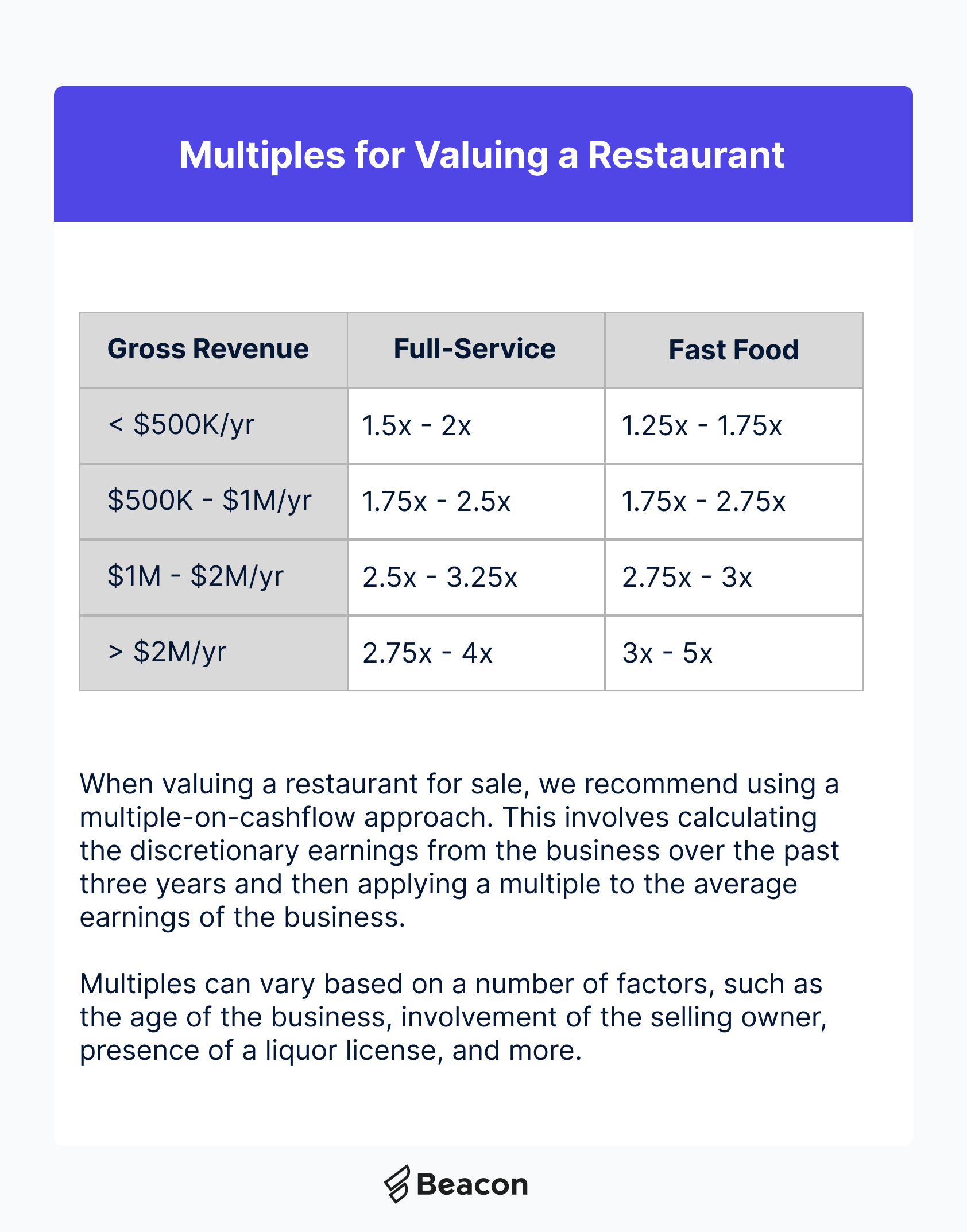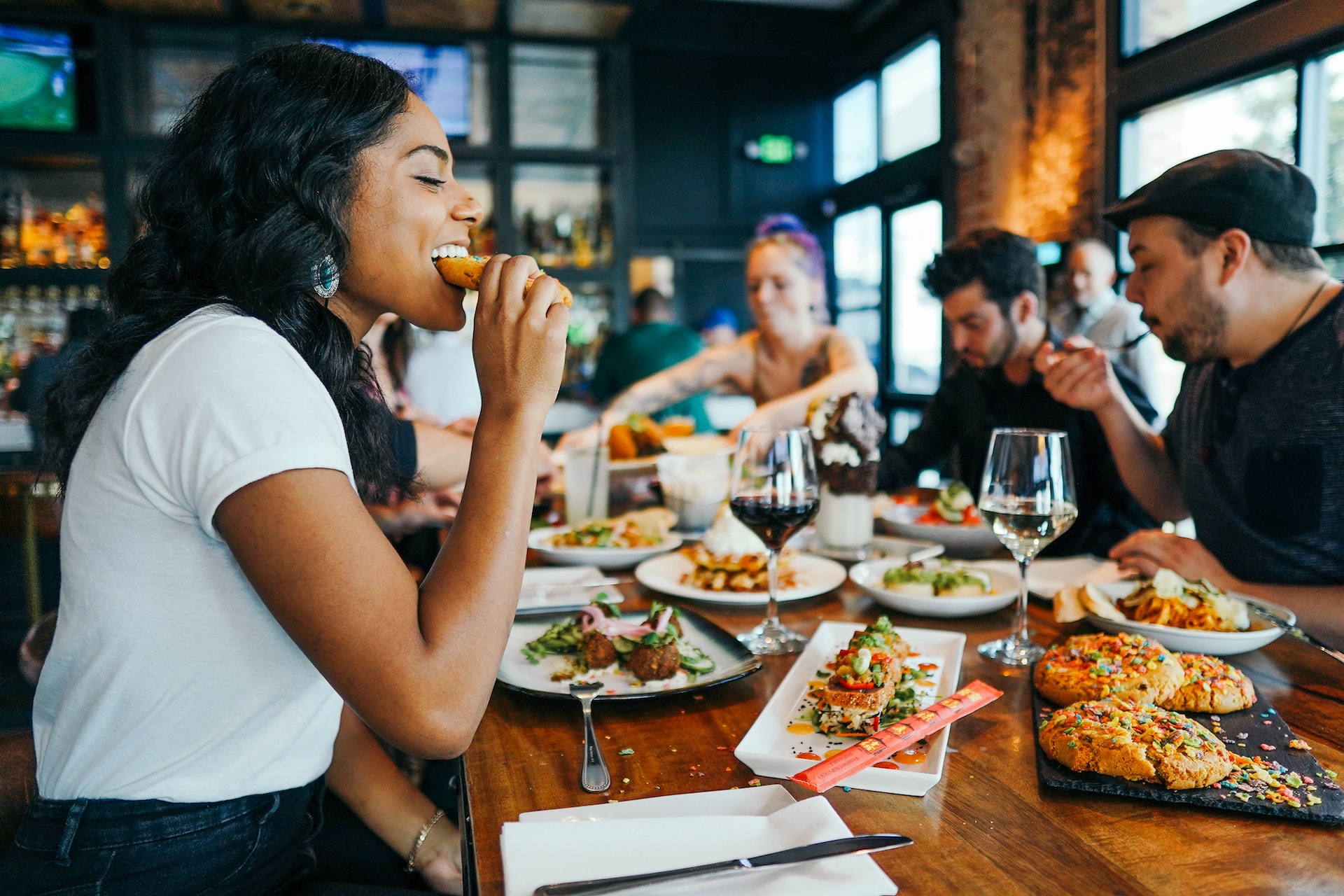Not quite ready to sell?
Subscribe to receive the latest resources for small business owners.
Considering selling your quick-service or sit-down restaurant? Unsure of how much it could be worth? Or, maybe you’re going through a financial planning exercise and want to know how much it is worth?
Beacon is the #1 solution for owners looking to sell their small businesses. As market leaders in the small business acquisition space, we work with dozens of restaurant owners each quarter. Whether you’re a family owned business or a relatively new upstart, chances are you don’t fully understand how a restaurant is valued. Luckily, we’re here to help.
What is the Purpose of a Business Valuation?
A small business valuation is designed to determine the price the average buyer would pay to take over ownership. For many businesses, the buyer would be an owner-operator looking to take over day-to-day management while earning additional income through cash flow distributions from the business.
The key word mentioned above is average. The goal is not to calculate the highest price that someone on planet Earth will pay nor the price that will sell the business the quickest.
Instead, the goal of a business valuation is to calculate the fair market value (FMV). The FMV of a business is what the average buyer of a business in a normal market would pay.
Owners may want to know the fair market value for a number of reasons.
Financial Planning: How much of my net worth is tied to my business? What are the key ways I can increase the value of my business?
Estate Planning: How much is my business worth? Should I put the business in a trust? How will I set myself up for retirement?
Divorce: What is the value of the business in the eyes of appraisers? How would I divide it up as an asset?
Retirement: How much longer should I continue to work before considering a sale? What are the likely sums of money a buyer would pay to buy me out?
Capital Raise: What is the pre-money valuation of the business? How much of the business will I need to sell to raise enough capital?
Partnerships: How much would it cost a partner to buy into a slice of the business? How much would it cost me to buy a partner out?
To calculate the fair market value, we recommend using the valuation method of seller’s discretionary earnings. This is the most common approach for valuing a “main street” business. In order to do that, owners need to first calculate their seller’s discretionary earnings and then determine the right multiplier to use.
How Much Is My Restaurant Worth?
As we discuss in how to value a cleaning business and how to value an auto repair business, the first step in a small business valuation is to calculate your earnings. The best bet is to use the past three years of federal tax returns. If you use Quickbooks or Xero for accounting or bookkeeping, we recommend exporting your profit-and-loss statements as well.
Once you have your financial statements ready to go, the initial analysis is to calculate Seller’s Discretionary Earnings (SDE) for the past 3 years. For a quick refresh on SDE, check out our blog deep dive on Seller's Discretionary Earnings! To calculate SDE, add up the following:
Net Income, as reported on the tax return
Interest, as reported on the tax return
Depreciation, as reported on the tax return
Amortization, as reported on the tax return
Owner Compensation: Add the owner’s salary from tax return as well as any benefits from your profit-and-loss statement such as retirement plans, healthcare that you as the owner get.
Discretionary Expenses: Add up any line items from your profit-and-loss statement that aren’t business related. Common examples include personal phone bills and country club memberships.
Now that we’ve added all of the discretionary items to net income, the next step is to adjust the earnings for what a new buyer would receive. Some common adjustments include the following:
If you own the restaurant’s building, are you under- or overpaying rent? Adjust the rent expenses to account for what you would charge the buyer of your restaurant on an ongoing basis.
Did you make a big purchase of a personal vehicle? Make sure to add back the cost of the vehicle (and subtract any depreciation), as the buyer would not be forced to make such a purpose.
Do you employ family members working as waiters, line cooks, or bookkeepers? Adjust the payroll to remove family members who do not work and factor in the market wages of family members who would need to be replaced.
Did you book PPP or EIDL as income? Make sure you remove any COVID-related loans from the income statement.
Lastly, we need to determine a fair summary of the SDE that a future owner can expect. Typically, this is a weighted average. In other words, we can’t simply pick the year with the highest SDE. We should average the last three years and weight the most recent year the heaviest, as things can change and typically the most recent year is the best depiction of where the business will be when a buyer takes over.
At Beacon, we use a somewhat complex weighted average formula, but we recommend owners performing a “back-of-the-envelope” valuation to weight the most recent year 50%, the second most recent year 37.5%, and the third most recent year 12.5%.
If your restaurant was forced to shut down during COVID, we recommend ignoring that year from the calculation and instead just doing a weighted average of non-COVID years.
Once this calculation is complete, you now have a good proxy for the earnings that a buyer would receive as the owner of your business.
What Multiple Should I Use?
A typical rule of thumb is to value a restaurant at 1.5x to 3x seller’s discretionary earnings. The exact multiple used is based on a number of factors, such as the time in business, the number of new hires a buyer would need to make, and the type of restaurant. As you can tell by the numbers below, the multiple can vary widely and depends on a number of data points. At Beacon, we take into account over 150 data points.
For those performing a quick valuation at home, we recommend the following approach which tiers multiples by annual revenue and type of restaurant (e.g., full-service vs. quick service):

What Drives Up the Value of My Restaurant?
Minimal Owner Involvement: If you’re a relatively passive owner, you can often slide up to the top-end of the multiple range for your revenue size. The number of potential buyers who can afford a restaurant but do not have time to actively operate it is greater than the number of potential buyers who can afford a restaurant and have time to actively operate it. As the saying goes, the more potential buyers, the better the price.
Minimal Family Involvement: We’ve seen a number of good restaurants where the owner has a few family members involved in running the business, whether they serve as line cooks, help run the cash register, or do the bookkeeping and payroll. The fewer family members involved, the better the multiple and value. Why? Because the new buyer does not need to worry about replacing a number of employees on day one.
Quality of Equipment: Kitchen equipment isn’t cheap. The better quality of your equipment, the more your restaurant is worth. The buyer can focus on ensuring a smooth transition without having to spend tens or hundreds of thousands of dollars on upgrading the equipment.
Liquor License: For states with strict alcohol laws, the prescence of a liquor license will drive up the value of the business. This is doubly true in states that have capped the number of licenses given out to establishments.
I-9 Verified Employees: It’s not secret that some restaurants are paying people under the table and are not verifying that all employees are authorized to work in the U.S. For restaurants with a clean back-office and strong habit of recordkeeping, buyers will often pay a premium.
Long-Term Lease: If you have a long-term or transferable lease, buyers will pay a premium as they do not need to worry about negotiating with the landlord over rent increases. For owners who own the real estate that their restaurants operate out of, they share in this benefit as well as they can draft a fair long-term lease with the buyer.
If you’d like to chat with someone about valuing your restaurant, please fill out our valuation request form. We’d be happy to craft a confidential restaurant valuation and walk through the ways you can improve your business.
Not quite ready to transact?
Subscribe to receive the latest resources for small business deals.

Sam is an exit planning expert, combining years of experience working with small business owners with extensive knowledge of traditional and SBA financing.
Information posted on this page is not intended to be, and should not be construed as tax, legal, investment or accounting advice. You should consult your own tax, legal, investment and accounting advisors before engaging in any transaction.

Calder Capital

Sam Domino


